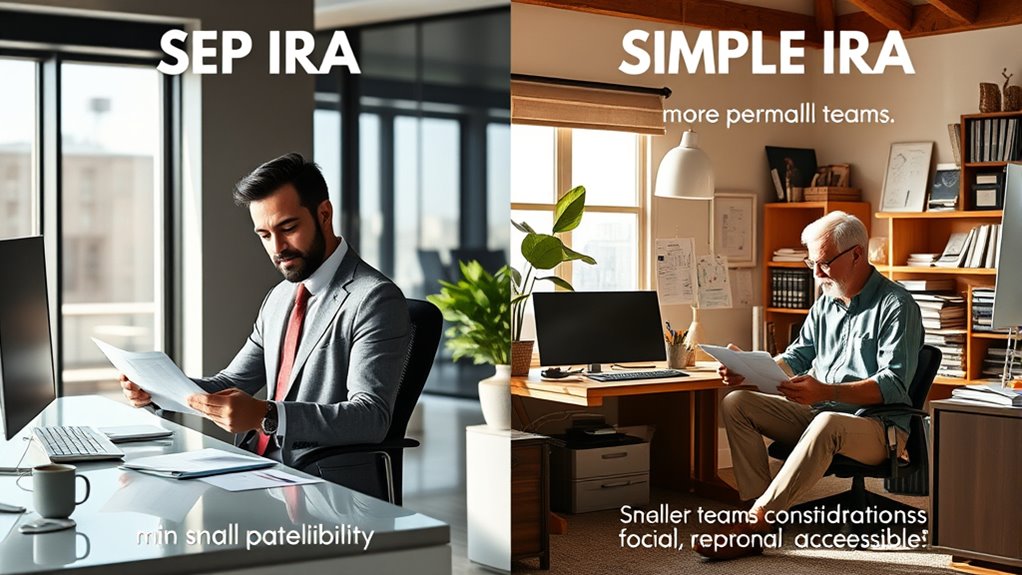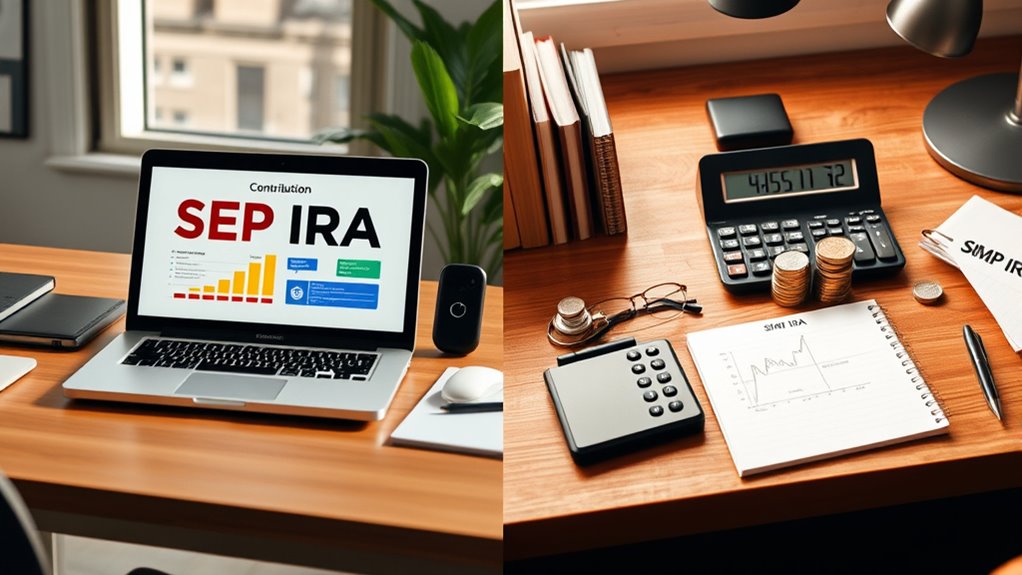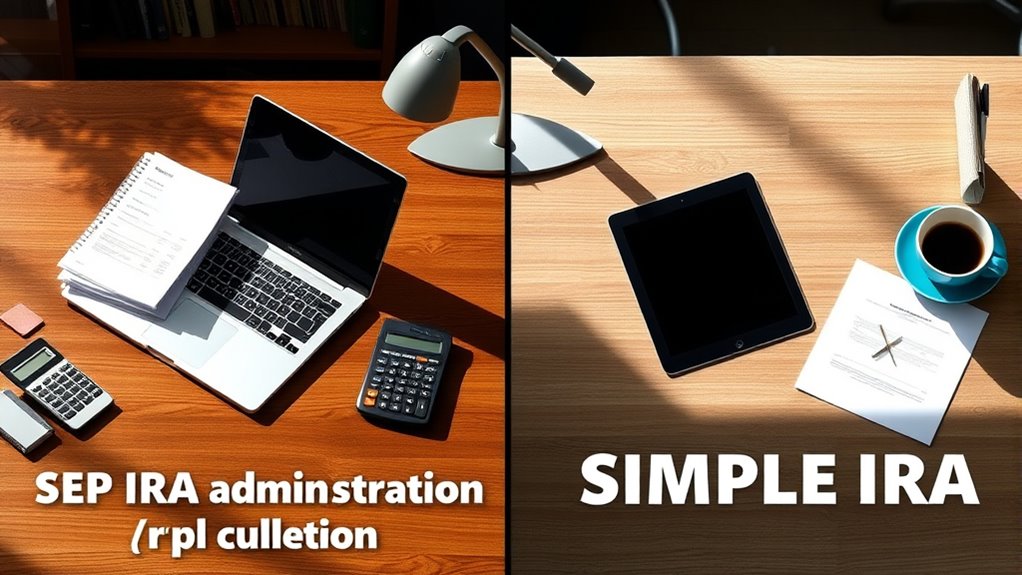If your business has fewer than 100 employees and you want flexible contributions, a SEP IRA might be best since you can contribute up to 25% of compensation and only do so if cash flow allows. A SIMPLE IRA works well if you want employee participation with salary deferrals and straightforward setup, but it requires mandatory employer contributions. To decide which suits your goals and cash flow, explore the key differences further.
Key Takeaways
- SEP IRAs are ideal for small businesses seeking simple, flexible contributions with minimal administrative burden; SIMPLE IRAs suit businesses wanting employee participation.
- SEP IRAs allow employer-only contributions up to 25%, offering flexibility during cash flow fluctuations; SIMPLE IRAs require mandatory employer contributions.
- SEP IRAs have fewer paperwork requirements and no annual filings, making them easier to manage for small business owners.
- SIMPLE IRAs facilitate employee savings with salary deferrals and matching, boosting employee engagement and retention.
- Choose SEP IRA for simplicity and flexibility; opt for SIMPLE IRA if encouraging employee participation is a priority.
Eligibility and Business Size Considerations

When choosing between a SEP IRA and a SIMPLE IRA, understanding their eligibility and business size requirements is essential. For plan setup, SEP IRAs are highly flexible, suitable for businesses of any size, including sole proprietors and larger firms. Employee eligibility typically requires workers to have worked three of the last five years, be at least 21, and earn a minimum of $750. In contrast, SIMPLE IRAs are limited to businesses with 100 or fewer employees. To qualify, employees must have earned at least $5,000 in previous years and expect similar earnings. Employee eligibility is broader for SIMPLE plans, encouraging participation, but the plan setup is more restrictive due to mandatory employer contributions. Your choice depends largely on your business size and your goals for employee involvement. SEP IRAs can be established quickly and with minimal paperwork, making them an attractive option for small business owners seeking simplicity. Additionally, understanding eligibility requirements can help ensure you select the most suitable retirement plan for your company.
Contribution Options and Limits

Contribution options and limits differ markedly between SEP IRAs and SIMPLE IRAs, shaping how you can save for retirement. SEP IRAs allow employer-only contributions of up to 25% of compensation, capped at $70,000 for 2025, with contributions made by the employer and flexible yearly adjustments. Investment options are typically broad, and vesting schedules are straightforward since contributions are fully vested immediately. In contrast, SIMPLE IRAs let employees contribute up to $16,000 in salary deferrals (plus catch-up contributions if age 50+), with employers choosing between matching contributions or nonelective 2% contributions. These plans have strict limits on total contributions and require accurate payroll data. Both plans offer different contribution flexibility and investment choices, but vesting schedules are generally simple, with immediate vesting for employer contributions in SIMPLE IRAs. Contribution limits are subject to annual inflation adjustments, which can influence how much you can save each year.
Administrative Responsibilities and Costs

Are administrative responsibilities and costs a key consideration when choosing between a SEP IRA and a SIMPLE IRA? Plan setup for a SEP IRA is straightforward, requiring only IRS Form 5305-SEP, with no annual IRS filings. In contrast, SIMPLE IRAs need initial filing of Form 5304-SIMPLE or 5305-SIMPLE and annual notices to employees, adding some administrative duties. Both plans keep paperwork manageable, avoiding the extensive reporting of 401(k)s. Costs are generally low for both, with minimal setup fees and administrative charges. However, SIMPLE IRAs involve mandatory annual employer contributions, which can increase administrative tasks related to tracking payments. Overall, SEP IRAs offer simpler ongoing administration, while SIMPLE IRAs require more consistent communication and recordkeeping. Studies also show that optimal angles can influence the longevity and scoring potential of pinball machines, highlighting the importance of proper setup and maintenance.
Flexibility and Impact on Business Cash Flow

Choosing between a SEP IRA and a SIMPLE IRA considerably impacts your business’s cash flow flexibility. With a SEP IRA, you can adjust contributions based on your business’s cash flow, making it easier to manage liquidity during lean years. You’re not required to make annual contributions, so you can skip or reduce payments without penalties, preserving cash. In contrast, SIMPLE IRAs require mandatory employer contributions—either a fixed 2% or a matching up to 3%—which can strain cash flow during low-revenue periods. Additionally, withdrawal penalties may apply if you access funds early. Investment options tend to be broader with a SEP IRA, allowing you to optimize your portfolio as your cash flow and business needs evolve. Color accuracy can also influence the performance of your investments within these accounts, impacting your overall returns. Overall, SEP IRAs offer greater flexibility and control over cash flow management.
Employee Participation and Retirement Benefits

How do employee participation rules differ between SEP IRAs and SIMPLE IRAs? With SEP IRAs, only eligible employees—those employed for at least 3 of the last 5 years and earning a minimum amount—are automatically included, and employees cannot opt out. In contrast, SIMPLE IRAs are more inclusive: most employees earning at least $5,000 in two previous years must be eligible, and employees can choose to opt out if they wish. Additionally, wall organization systems can be used within the workplace to visually communicate retirement plan options and encourage participation. Here are key points:
- Employee opt out: Allowed in SIMPLE IRAs, not in SEP IRAs.
- Contribution flexibility: SEP IRAs rely solely on employer contributions, while SIMPLE IRAs allow employee salary deferrals.
- Participation rules: SIMPLE IRAs require inclusion of nearly all eligible employees; SEP IRAs include only those meeting criteria.
- Benefits: SIMPLE IRAs encourage employee savings with matching options, whereas SEP IRAs depend on employer discretion.
Frequently Asked Questions
Can I Convert My SEP IRA to a SIMPLE IRA Later?
You can do an IRA conversion to move your SEP IRA into a SIMPLE IRA, but only after the SIMPLE IRA has been active for at least two years, according to the two-year rule. This is part of a retirement rollover process permitted by recent IRS updates. Make sure to follow proper procedures and documentation to avoid penalties and ensure your retirement rollover complies with IRS regulations.
Are There Any Penalties for Changing Plans Mid-Year?
If you’re considering a plan termination mid-year, there are no explicit penalties, especially with the penalty waiver introduced by SECURE 2.0 allowing mid-year SIMPLE IRA plan termination. However, you must follow strict notification rules to avoid penalties, like providing timely notices to employees. While the IRS hasn’t banned mid-year changes, failing to meet notice requirements could trigger penalties, so make certain you comply with all deadlines to avoid issues.
How Do Plan Audits Differ Between SEP and SIMPLE IRAS?
When you compare SEP and SIMPLE IRA audits, you’ll notice different procedures and compliance requirements. SEP audits focus on verifying discretionary contributions and proper plan amendments, while SIMPLE IRA audits emphasize employer contribution formulas, annual employee notifications, and adherence to contribution limits. Both require timely updates of plan documents, but SIMPLE plans demand stricter compliance with notification and contribution rules, making audit procedures distinct for each.
Can Self-Employed Individuals Qualify for Both Plans Simultaneously?
Ever wonder if you can access the full potential of your retirement savings? The answer lies in eligibility overlap and plan combination. Yes, as a self-employed individual, you can qualify for both plans simultaneously. But beware: you must coordinate contributions carefully to avoid exceeding IRS limits. Managing both plans requires strategic planning, ensuring you maximize benefits without falling into penalties. It’s a smart move if done right, but stay vigilant!
What Are the Rollover Rules if I Switch Plans or Providers?
When you switch plans or providers, you need to follow specific rollover procedures and plan transfer rules. Generally, you can roll over a SEP IRA into another IRA or qualified plan anytime without penalty. SIMPLE IRAs, however, have a two-year waiting period before you can roll over into other plans without penalties. Make sure to complete the rollover within 60 days and use trustee-to-trustee transfers to avoid unnecessary taxes or penalties.
Conclusion
Choosing between a SEP IRA and a SIMPLE IRA is like picking the right key for your business’s financial future. Both offer unique advantages, but your decision hinges on your business size, goals, and administrative capacity. Think of it as a dance—you want to find the rhythm that best aligns with your growth. Ultimately, selecting the right plan isn’t just about today’s savings but about shaping tomorrow’s success. The choice is yours—make it wisely.









